Mailchimp
Using Squeezely with Mailchimp
Find out how to use Squeezely the integration between Squeezely and Mailchimp. This guide covers:
- Setting up the connection
- Data Syncing between Squeezely & Mailchimp
- Using audiences in Mailchimp
- Triggering a Mailchimp automation from Journey Builder
- Statistics from Mailchimp
Setting up a connection between Squeezely and Mailchimp
Go to your company settings and find the Mailchimp section. On below form, fill in all the fields.Find an explanation for all fields below.
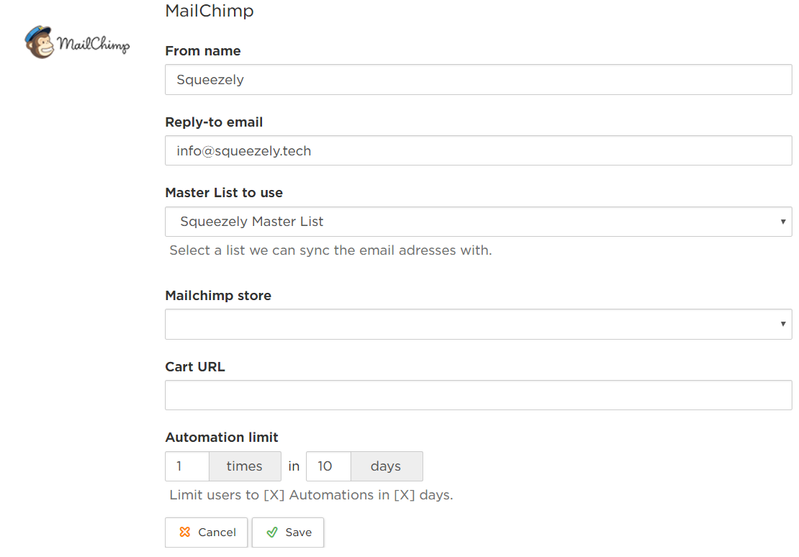
From name
This will be the default name entered in the 'From' field when creating a Mailchimp campaign.
Reply-to email
This will be the default email address entered in the 'Reply-to email' field when creating a Mailchimp campaign.
Master List to use
Select your Mailchimp Masterlist you want Squeezely to sync with. If left empty a new masterlist will be created.
Mailchimp Store
Select the Mailchimp store you want Squeezely to sync with. If left empty a new store will be created.
Cart URL
When using Mailchimp automations this URL will be used to redirect users to their shopping cart. This can be for example www.yourstore.com/cart or just the main page of your store.
Automation Limit
The automation limit makes sure you don't send to many automated emails to your customers. 1 times in 10 days, will make sure that no more than 1 automated email is sent to any user in a period of 10 days.
Data syncing between Squeezely & Mailchimp
Squeezely syncs data with Mailchimp in the following cases:
- When an audience is published from Squeezely
- When a user needs to be added or removed from a segment based on your audience criteria in Squeezely
- Each time a segment is updated, Squeezely updates custom fields for these profiles as well.
- New opt ins received by Squeezely are automatically synced to Mailchimp on a daily basis.
- New opt ins received by Mailchimp are automatically synced to Squeezely on a daily basis.
Identify visitors from Mailchimp Using URL Tags
When your campaign is finished, a screen will show you which tags to use in order to track visitors from your campaign. For Mailchimp this URL tag will look like this:
?sqzl_campaign={Identifier}&sqzl_source=mailchimp&email=* | EMAIL_HASH | *
Campaign Identifier
The campaign identifier is used to track from which email campaign a visitor clicked to your website. This is set using the tag sqzl_campaign and contains the identifier you have set in step 1 of your campaign. You can use this information later to create an audience of all your campaign visitors. Also it will be used to determine how many visitors came to your website from the campaign in Squeezely Dashboard.
Source Identifier
This identifier represents the source and should always be 'mailchimp'. This will enable you to create an audience of all website visitors that have visited you website from any Mailchimp campaign. Also it enables a grouping off all visitors coming from your Mailchimp campaigns in Squeezely Dashboard.
Email Identifier
The email identifier is used to identify which CRM user is visiting your website. For increased privacy of your visitors the email address needs to be encrypted first, in stead of exposing the address in the URL. To to this Squeezely has synced an encrypted version of the address to Mailchimp. This can be loaded into your URL by adding the merge tag: * | EMAIL_HASH | * .
By adding the URL tag email=* | EMAIL_HASH | * to all your Mailchimp campaigns, Squeezely will be able to match people from your uploaded CRM files to website visitors automatically.
Using Squeezely Audiences in Mailchimp
Following below steps will show you how to export an audience from Squeezely and where to find it in Mailchimp.
Exporting your audience
- Create an audience in Squeezely Audience Builder.
- Select Mailchimp as export channel.
- Press 'save'.
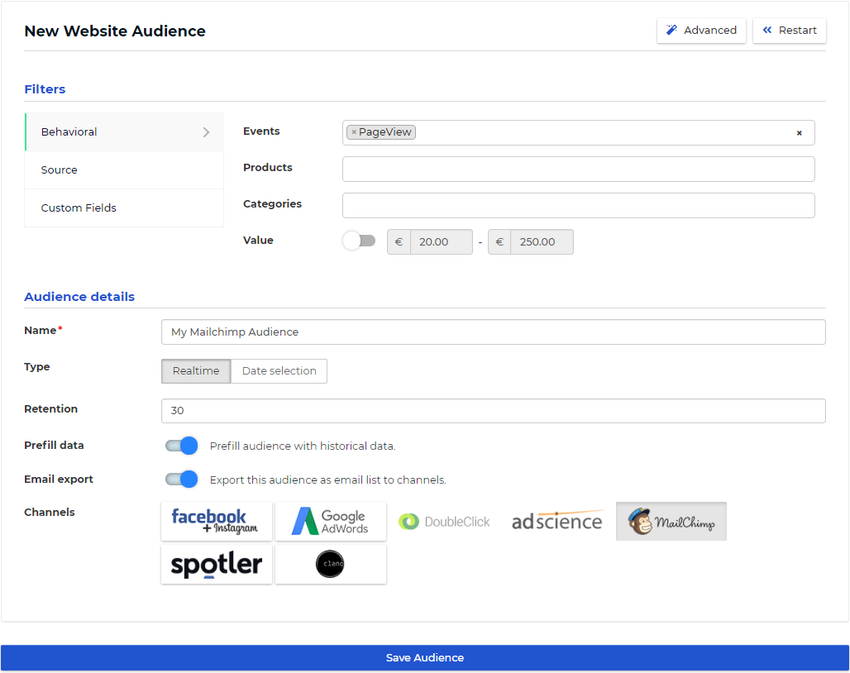
Viewing your audience in Mailchimp
- Login to your Mailchimp account.
- Navigate to 'Lists' on the top left of your screen.
- Click on the list you have connected to Squeezely.
- Open the drop down menu under 'Filter By Tags'.
- Search for your audience name in the drop down and select it to see who qualifies for this audience.
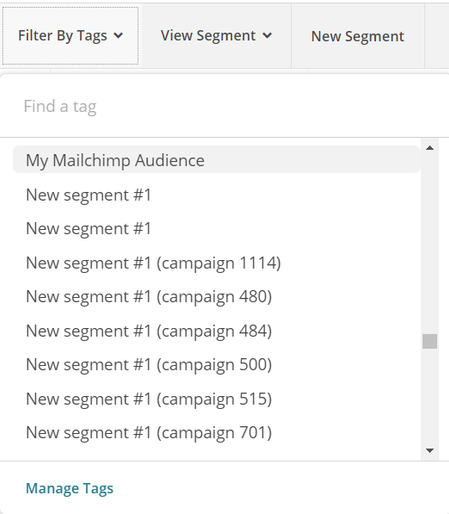
Sending a campaign to your audience from Mailchimp
After completing the steps under 'Viewing your audience', continue with below steps to send this group a campaign from within Mailchimp.
- Find the button 'Send Campaign'
- Select the option 'An email campaign'
- Complete the steps in Mailchimp


Triggering a Mailchimp Automation from Journey Builder
You are able to trigger Mailchimp Automations directly from Squeezely Journey Builder.
In below example the 'play' icon determines who will enter your journey. In this case an email will be sent to everybody that enters your journey after 1 day.
Find out more about building journeys here.
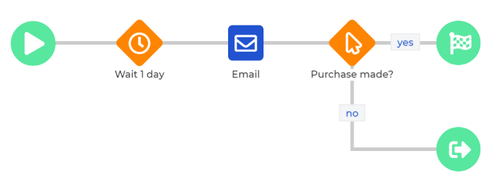
When using our Mailchimp connection sending of the email triggers will be handled by Mailchimp. You can select which automation should be triggered within the email object in a journey.
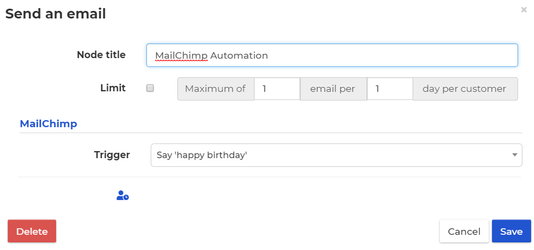
Before you will find any automations in Squeezely Journey Builder, first you have to create an automation in Mailchimp. Find out how to do so below.
Creating your automation in Mailchimp
- Log in to Mailchimp
- Create a new campaign of type 'email'
- Choose subtype 'Automated'
- Within the different options for automated campaigns, select API 3.0. This can be found within the tab API.
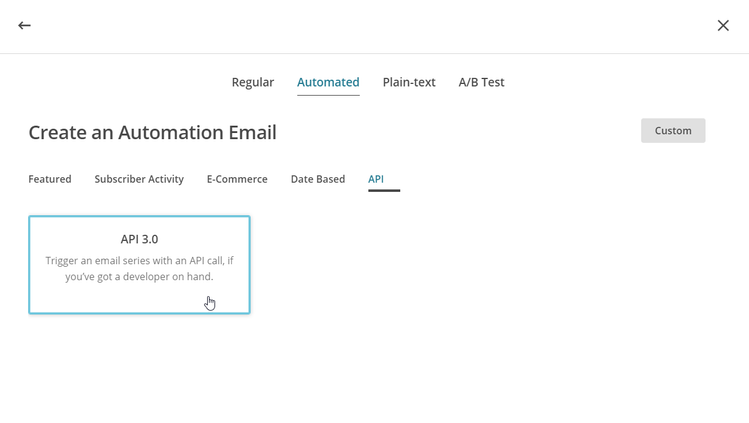
On the next screen, you give a name to your automation. This name will be listed in Squeezely Campaign Builder later.
From the drop down menu, select the list you have connected to the Squeezely Platform.
Now press Begin.
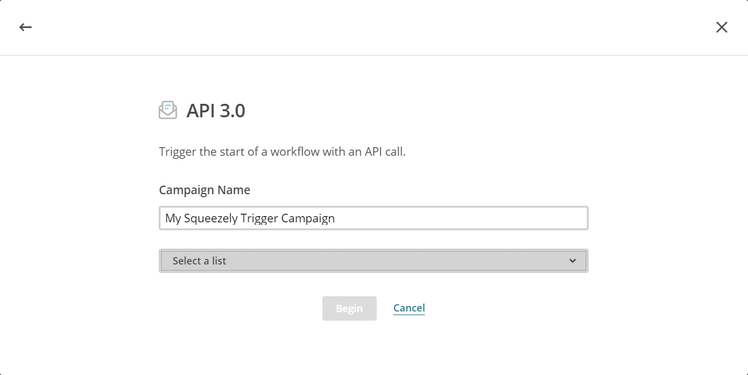
On the next screen, you will see an item named 'First API call'. This is the message that will be triggered by your Squeezely campaign.
NOTE: Squeezely will trigger only your First API call in the campaign flow. By default Mailchimp will give you 3 triggers that are activated by seperate API calls.
Go ahead and remove two of them, so your canvas will look like the example below.
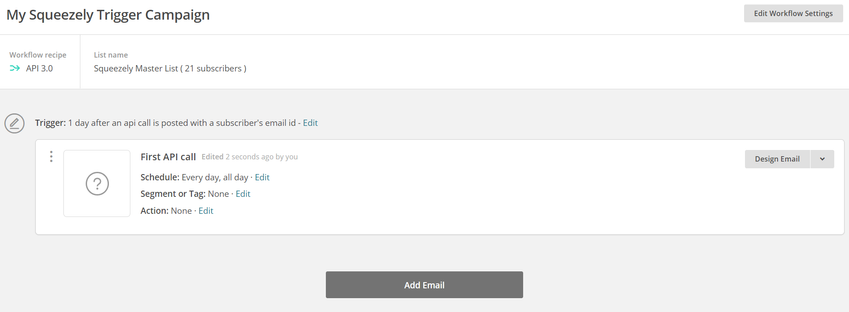
You have a couple of options to set up your automation in Mailchimp:
Design Email: This enables you to select the template for the email that will be triggered.
Add Email: Here you are able to decide follow up actions performed by Mailchimp after your initial mail trigger has been sent. For example send another mail if the original has not been opened and much more. To do this add an email and press 'edit trigger'. This will give you the options you see below.
When your done, save your automation and start it.
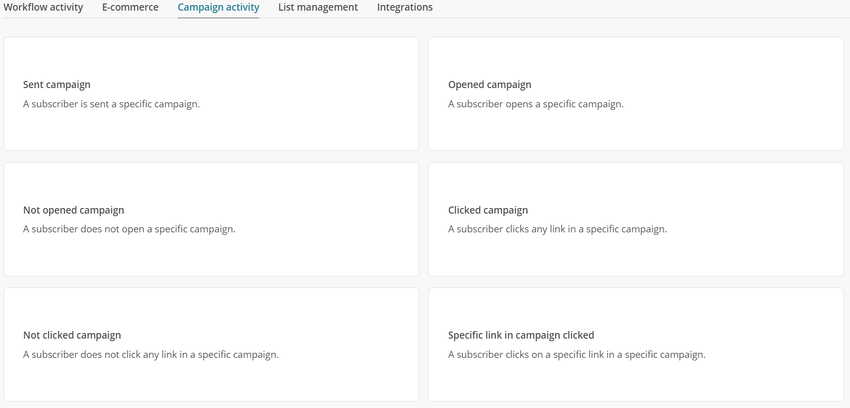
Search
Navigate
Want to find info about a specific feature? Check out these topics below!